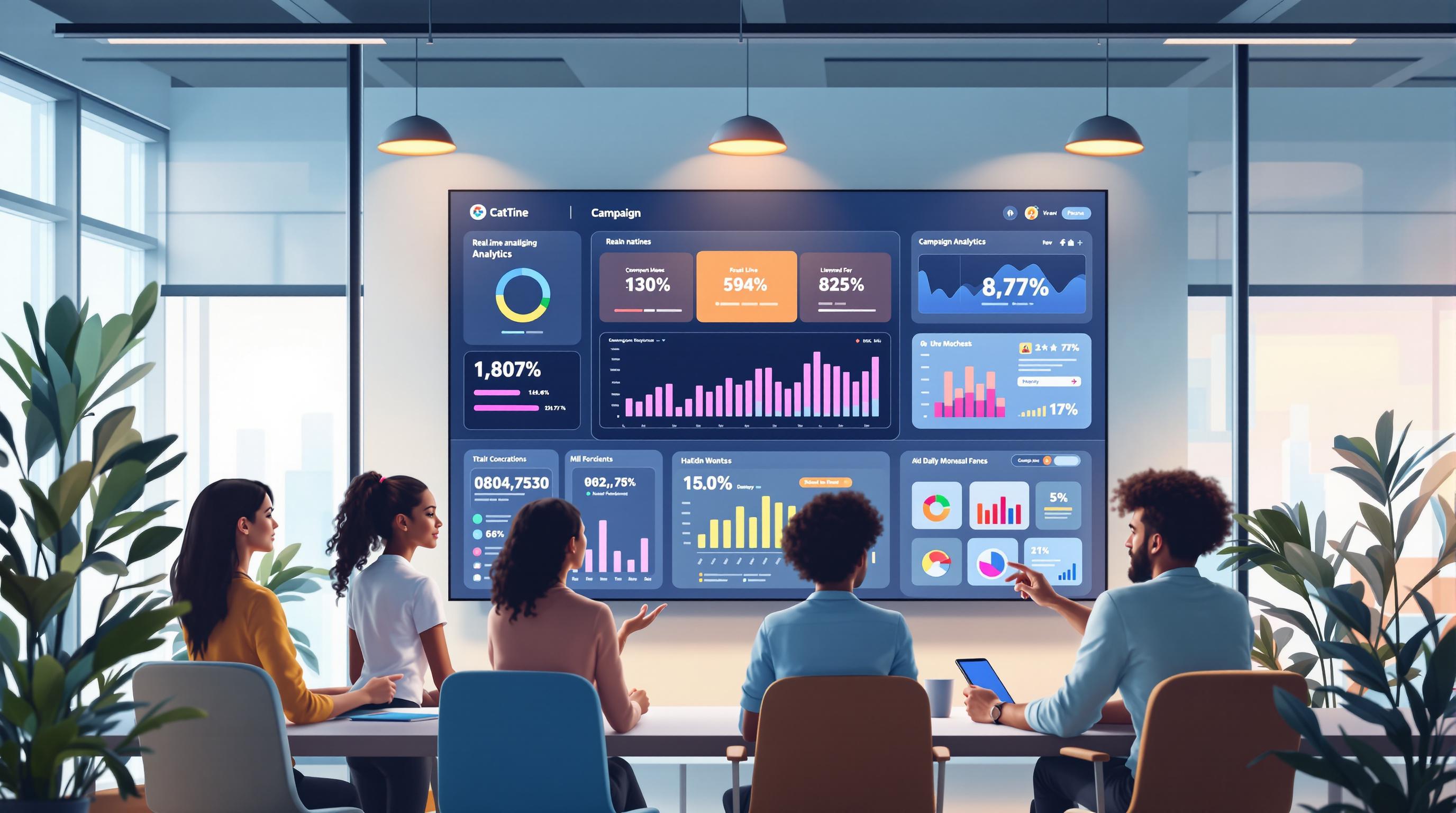Real-time monitoring in A/B testing lets you track experiment results as they happen, enabling faster decisions and better outcomes. Instead of waiting days for insights, you can see live updates on metrics like conversion rates and click-through rates. This approach helps identify winning variations early, shut down underperforming ones, and detect problems like technical glitches or unexpected user behavior quickly.
Key Takeaways:
- Faster Decisions: Immediate access to live data means you can adjust or end tests without delay.
- Improved Conversion Rates: Early insights allow tweaks to headlines, CTAs, or design elements for better performance.
- Problem Detection: Spot issues like broken links or data errors before they escalate.
- Collaboration: Shared dashboards keep teams aligned using up-to-date information.
- Example: Expedia stopped a test in minutes after detecting a 39% drop in conversions, saving revenue and trust.
To set it up, choose tools with real-time tracking, create dashboards highlighting key metrics, and configure alerts for anomalies. While real-time data is helpful, avoid acting on early trends without statistical significance. Use this approach to refine your marketing strategies and boost results effectively.
Understanding the User Journey with A/B Tests | LogRocket & AB Tasty
Benefits of Real-Time Monitoring
Real-time monitoring transforms A/B testing into a dynamic process, allowing teams to actively optimize their strategies. By providing instant performance metrics as users interact with test variations, it enables quicker and smarter decisions.
Faster Decision-Making and Optimization
Traditional A/B testing often requires hours - or even days - to gather enough data for actionable insights. With real-time monitoring, teams can access live results immediately.
"With real-time A/B testing monitoring, you get instant access to live results and see exactly how users are behaving. This means your team can quickly react to trends and changes, tweaking things on the fly to make the user experience even better." – The Statsig Team
This speed empowers teams to identify winning variations early and implement changes without delay. If a variation shows promising results, traffic can be redirected to maximize its impact or prepare for a broader rollout. On the flip side, underperforming versions can be adjusted or removed quickly, saving valuable time and resources. Additionally, real-time data fosters better collaboration across departments, as product managers, marketers, and engineers can align their decisions using up-to-the-minute insights.
These advantages lay the foundation for more effective conversion strategies.
Better Conversion Rate Optimization
Real-time monitoring has a direct impact on improving ROI by helping teams make adjustments faster. Identifying and eliminating poorly performing variations early ensures that more users experience the versions that drive higher engagement and conversions.
For example, dynamic adjustments - like refining headlines, images, or calls-to-action (CTAs) - can significantly boost outcomes. Facebook Marketplace demonstrated this by achieving a 26× increase in online transactions over six months. This kind of agility is especially valuable when user preferences shift quickly or external factors influence behavior.
By acting quickly, teams not only enhance conversions but also prevent small issues from snowballing into bigger problems.
Early Problem Detection
Real-time monitoring isn't just about optimization - it’s also a critical tool for catching problems early. Technical glitches, broken links, or unexpected user behavior can disrupt tests and compromise results, making a reliable early-warning system essential.
"When an experimenter designs an experiment and divides traffic between them, it's very critical to know if something is wrong with experiment as soon as possible." – Reza Esfandani, Software Engineer
According to a Forrester report, companies that effectively integrate A/B testing with real-time feedback can see up to a 30% increase in conversion rates and a 20% reduction in downtime caused by bugs. This underscores how early detection safeguards both revenue and user experience.
Some common issues that real-time monitoring can quickly identify include:
- Technical errors, such as broken checkouts or loading failures
- Usability problems, like confusing navigation or unclear messaging
- Data collection errors that could compromise test validity
- Unexpected user behavior, which might indicate external factors impacting results
How to Set Up Real-Time Monitoring for A/B Testing
Setting up real-time monitoring for A/B testing requires thoughtful preparation. This involves selecting the right tools, creating intuitive dashboards and alerts, and ensuring that data remains accurate throughout the testing process.
Choosing the Right Tools
The foundation of effective real-time monitoring lies in picking an A/B testing platform that can handle live data streams while maintaining precision. Look for platforms that support event tracking, data pipelines, and real-time visualization to process information instantly.
Key features to prioritize include visual editors for creating test variations, detailed reporting dashboards, seamless integration with your existing tools, and strong security measures. Many platforms also offer safeguards that automatically flag or pause variations that negatively impact critical metrics.
If you're evaluating different A/B testing tools, the Marketing Analytics Tools Directory (https://topanalyticstools.com) is a helpful resource. It allows you to compare platforms based on their real-time analytics capabilities, A/B testing features, and integration options.
For instance, platforms like Statsig showcase how real-time monitoring can provide immediate insights and centralized tracking of key metrics.
Once you've chosen your platform, the next step is to set up dashboards and alerts for real-time visibility and quick responses.
Setting Up Dashboards and Alerts
After selecting your tools, configuring dashboards and alerts is essential for tracking test performance effectively. Design dashboards that highlight critical metrics visually. Focus on primary metrics like conversion rates and click-through rates, while including secondary metrics such as bounce rates to provide additional context. Customizing dashboard views ensures that team members can access the data most relevant to their roles.
Alerts play a vital role in real-time monitoring. Set up automated notifications for key metrics like conversion rates, session duration, and bounce rates. Define thresholds that trigger alerts when performance indicators deviate from expected ranges. To reduce false alarms, consider platforms that use AI-based anomaly detection. These tools analyze historical patterns to adjust thresholds dynamically, ensuring that alerts are sent only when genuine issues arise.
For a more tailored approach, implement role-specific dashboard access. This way, product managers can focus on strategic metrics, while engineers monitor technical performance.
Once dashboards and alerts are in place, it's equally important to ensure data accuracy and compliance with legal standards.
Maintaining Data Accuracy and Compliance
Accurate data is the cornerstone of reliable real-time monitoring. Regularly test and validate your data collection methods to catch and fix errors that could undermine your results. Automated systems can help identify anomalies early, preventing them from affecting your tests.
Even with real-time insights, statistical rigor is non-negotiable. Set proper thresholds for statistical significance and ensure sample sizes are sufficient for trustworthy outcomes. While real-time data provides quick insights, final decisions should only be made once statistical significance is achieved.
Compliance with data protection laws, such as GDPR or CCPA, is another critical aspect of real-time monitoring. Anonymize user data, handle it securely, and provide users with options to opt out of tests. This not only ensures legal compliance but also upholds the integrity of your testing process.
Technical infrastructure also plays a key role in maintaining accuracy. Factors like seasonality, user behavior changes, and external events can influence test results, so it's important to account for these variables. Regular validation checks can help identify when external factors might skew your data.
Finally, establish backup systems for critical data and protocols for handling collection failures. These measures ensure that your real-time monitoring remains dependable, even when technical challenges arise.
In short, a well-designed infrastructure ensures that real-time monitoring delivers fast insights without compromising on data quality or user privacy.
sbb-itb-5174ba0
How to Interpret Live Data
Once your dashboards are set up, the next challenge is making sense of the live data they provide. Real-time data can be a game-changer for A/B testing, offering immediate insights into performance. However, rushing to conclusions based on early trends can undermine the accuracy of your results. The trick is to interpret the data carefully and avoid jumping to conclusions too soon.
Avoiding Early Decisions
It's tempting to act on early trends, but doing so can lead to misleading outcomes. Data often fluctuates significantly over short periods, making it unreliable for decision-making early on. Instead, define the test duration and minimum sample size before starting. This ensures you’re working with stable, reliable data, rather than reacting to short-term noise.
"Extraordinary claims require extraordinary evidence."
For instance, Copy Hackers extended a test that had already reached 95% significance by day six. By doing so, they saw a 24% boost in conversions and increased confidence levels from 95% to 99.6%. Combining real-time monitoring with periodic reviews of cumulative results - and setting up smart alerts for major shifts - helps ensure your decisions are grounded in solid insights.
The next step is to focus on tracking key metrics and identifying anomalies for deeper validation.
Tracking Key Metrics and Anomalies
To make sense of your data, concentrate on metrics that align with your goals. Primary metrics like conversion rates, click-through rates (CTR), and revenue offer direct insights into performance. Secondary metrics, such as bounce rates, session duration, scroll depth, and average order value (AOV), provide valuable context. For e-commerce sites, micro-conversions - like product page views, add-to-cart actions, clicks on recommendations, or newsletter signups - can reveal more about your audience's behavior.
Meghan Carreau, Co-Founder & Executive UX Design Officer at Aztech, shares her approach:
"Typically, you need to get to statistical significance, so a particular threshold you set for the test parameters indicates there's been enough traffic over a given amount of time to start assessing the data. I typically start reporting after two weeks, but it depends on the brand and the site traffic. Then weekly reports are generated and presented to the client or team."
Segmenting your data by traffic source, visitor type, or device can uncover how different groups respond to changes. Regular monitoring helps maintain accuracy, and documenting external factors - like marketing campaigns, seasonal trends, or website outages - can explain unexpected anomalies. Paying attention to p-values and confidence intervals can further confirm whether observed differences are statistically significant.
With metrics in place, the next step is knowing when to act on your findings.
When to Pause, Adjust, or End Tests
Intervene only when your pre-established stopping rules are met. Pavel Dmitriev, VP of Data Science at Outreach, outlines their approach:
"At Outreach, we recommend shutting down an experiment when all four of the following conditions are true: (a) we have at least 100 deliveries in each variant (b) we have at least 30 replies combined across both variants (c) we see a degradation of 30% or more in replies (d) additionally, if the experiment is running on multiple sequences, none of them show a positive trend."
Running tests for at least seven days helps account for daily traffic and behavior variations. If statistical significance isn’t reached in that timeframe, extending the test for another week might be necessary. Real-world examples illustrate the value of patience. BaseKit, for example, redesigned their pricing page and hit 95% significance within 24 hours, leading to a 25% increase in conversions. Similarly, ConversionXL documented a case where an initially underperforming variant surpassed its competitor by over 25% once the test reached statistical significance. TruckersReport took a long-term approach, running iterative tests over six months and boosting conversions from 12% to 79.3%.
Connecting Real-Time Monitoring to Marketing Strategy
Real-time A/B testing monitoring can become a game-changer when it's tied directly into your marketing analytics framework. When done right, it connects the dots between test results and overall campaign performance, enabling smarter, data-driven decisions across all marketing channels.
Linking Experiment Data to Marketing Analytics
The value of real-time A/B testing grows exponentially when it’s integrated with your broader marketing analytics system. This connection allows you to see, in real time, how test outcomes influence key metrics like campaign performance, customer behavior, and revenue.
To make this happen, integrate tools like event tracking, data pipelines, and visualization software into your dashboards. This ensures that A/B test results are automatically reflected alongside other performance data, offering a unified view of your campaigns.
Take, for example, an e-commerce brand that used AI-driven analytics to track website performance in real time. By spotting drop-off points in their customer journey through testing data, they fine-tuned their checkout process, leading to a 25% boost in conversion rates. In another case, a B2B SaaS company leveraged AI to automate A/B testing for email campaigns. By analyzing results in real time, they optimized their messaging, achieving a 40% increase in engagement rates and attracting more qualified leads.
This kind of integration doesn’t just improve metrics - it promotes collaboration. When teams have shared, up-to-the-minute access to experiment performance, it streamlines decision-making across marketing, product, and analytics teams. By tracking primary metrics like conversion rates and revenue alongside secondary ones like bounce rates and session duration, you gain a comprehensive view that supports immediate, strategic adjustments.
Using Directories for Tool Selection
Once your data integration is in place, choosing the right tools becomes critical. The Marketing Analytics Tools Directory can simplify this process by letting you compare platforms designed for real-time analytics and A/B testing.
This directory offers insights into tools across categories like campaign tracking, audience analysis, and business intelligence. Experts emphasize that A/B testing tools are a cornerstone of any effective conversion strategy. When evaluating options, look for platforms that can automate group assignments, connect to panels instantly, conduct significance testing, and display results in real time. These capabilities ensure your tools work seamlessly with your existing marketing stack.
Whether you're a small business seeking basic solutions or an enterprise needing advanced data pipelines, the directory helps you make informed decisions by organizing tools into clear categories. Selecting platforms that integrate smoothly with your systems amplifies the impact of real-time monitoring.
"A/B testing is the most powerful way to convert clicks into customers by allowing marketers to systematically experiment with different marketing strategies and identify the most effective approaches." - Siroker and Koomen
Conclusion
Real-time monitoring transforms A/B testing into a tool that offers immediate insights, allowing you to make decisions based on live data rather than waiting days for results.
This approach not only minimizes costly mistakes by quickly identifying underperforming variations but also enhances collaboration. Teams gain access to shared, up-to-the-minute experiment performance data, ensuring everyone stays aligned. Plus, you can act on successful variations right away, maximizing their impact on conversion rates and revenue.
Companies leveraging real-time monitoring have reported impressive results: 36% of experiment-related issues are detected automatically within the first 24 hours, saving thousands of testing days by swiftly catching misconfigured experiments. Considering that 80% of customers expect a response within 24 hours and 60% stop doing business after poor service experiences, the ability to act quickly is more important than ever.
FAQs
How does real-time monitoring improve decision-making during A/B testing?
Real-time monitoring enhances decision-making in A/B testing by providing immediate access to live data. This means you can spot trends as they unfold, make quick adjustments, and tackle issues early - helping to avoid potential revenue losses or unhappy users.
With live metrics at your fingertips, testing hypotheses becomes more efficient, keeping your campaigns flexible and responsive. This method allows you to fine-tune results more quickly and ensures your strategies are guided by the most current insights.
What should I look for in a tool to monitor A/B tests in real time?
When choosing a tool for monitoring A/B tests in real time, it's important to consider how simple it is to use and how well it integrates with your existing systems. A tool that offers real-time reporting is key, allowing you to track performance as it unfolds and address any issues immediately.
It's also worth looking for solutions that provide advanced analytics, like in-depth audience segmentation and predictive insights. These features can guide you in making smarter, data-backed decisions. Additionally, tools with continuous monitoring capabilities can help you identify trends and fine-tune your tests for better results.
How does real-time monitoring ensure data accuracy and compliance during A/B testing?
Real-time monitoring is essential for maintaining data accuracy and ensuring compliance during A/B testing. By offering immediate access to live test results, it enables you to spot and resolve any inconsistencies or anomalies as they happen, minimizing the chances of errors slipping through.
It also plays a key role in upholding privacy regulations by keeping track of consent and compliance protocols during data collection. This approach not only strengthens confidence in your test results but also safeguards your business from potential regulatory pitfalls.


